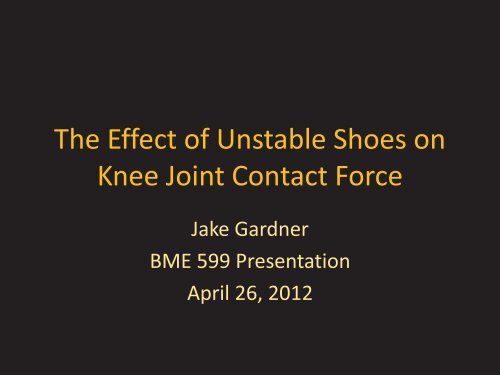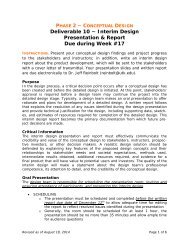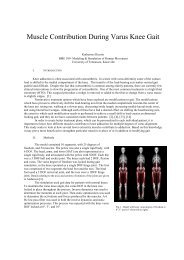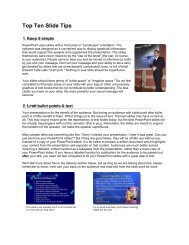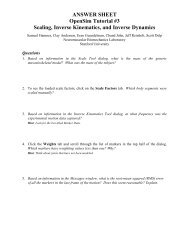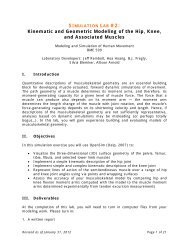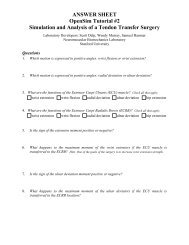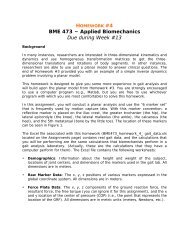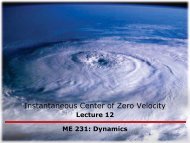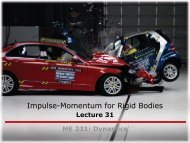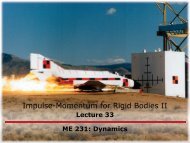The Effect of Unstable Shoes on Knee Joint Reaction Forces
The Effect of Unstable Shoes on Knee Joint Reaction Forces
The Effect of Unstable Shoes on Knee Joint Reaction Forces
You also want an ePaper? Increase the reach of your titles
YUMPU automatically turns print PDFs into web optimized ePapers that Google loves.
<str<strong>on</strong>g>The</str<strong>on</strong>g> <str<strong>on</strong>g>Effect</str<strong>on</strong>g> <str<strong>on</strong>g>of</str<strong>on</strong>g> <str<strong>on</strong>g>Unstable</str<strong>on</strong>g> <str<strong>on</strong>g>Shoes</str<strong>on</strong>g> <strong>on</strong><strong>Knee</strong> <strong>Joint</strong> C<strong>on</strong>tact ForceJake GardnerBME 599 Presentati<strong>on</strong>April 26, 2012
Introducti<strong>on</strong>• <str<strong>on</strong>g>Unstable</str<strong>on</strong>g> shoes have gained recent popularity• Claims for the efficacy <str<strong>on</strong>g>of</str<strong>on</strong>g> the shoe include:– Increased muscle t<strong>on</strong>e– Improved posture– Reduce pressure <strong>on</strong> feet– Potential benefit for diseased populati<strong>on</strong>s such asknee osteoarthritis (OA)
Introducti<strong>on</strong>• Previously, our lab has d<strong>on</strong>e gait analyses <strong>on</strong>two different unstable shoes1 st Generati<strong>on</strong> 2 nd Generati<strong>on</strong>
Purpose and Hypothesis• Determine the knee joint c<strong>on</strong>tact forces inhealthy individuals while walking with anunstable shoe compared to a c<strong>on</strong>trol shoe• Hypothesis: Wearing the unstable shoe willdecrease the vertical knee joint c<strong>on</strong>tact force
Experimental DesignExperimentalData• Walk acrossforce plate inc<strong>on</strong>trol andtest shoes• 3D Moti<strong>on</strong>Capture• EMGVisual 3D• Process data• Performinversedynamics• Export moti<strong>on</strong>trials toOpenSimOpenSim• Scale V3Dmodel toOpenSimmodel• Perform RRA• Perform CMC•Calc JRF
Methods: Data Collecti<strong>on</strong>• 14 healthy men– Age: 45.4 ± 8.4 yrs– Height: 1.82 ± 0.07 m– Weight: 83.2 ± 13.5 kg• Walked at 1.3 m/s across a force plate– In c<strong>on</strong>trol and test shoes• 3D moti<strong>on</strong> capture with reflective markers– Bilateral marker set
Methods: OpenSim Processing• Exported walking to use in OpenSim• Scaled V3D model to OpenSim model• Performed residual reducti<strong>on</strong> analysis (RRA)• Performed computed muscle c<strong>on</strong>trol (CMC)• Performed JRFcalculati<strong>on</strong>
CMC1500100050000 20 40 60 80 10015001000500EMG3002502001501005000 20 40 60 80 10010864200 20 40 60 80 1001500100050002001501000500 20 40 60 80 10000 20 40 60 80 10000 20 40 60 80 100150080100060405002000 20 40 60 80 10000 20 40 60 80 100
Results: <strong>Knee</strong> C<strong>on</strong>tact ForceWhy is the 2 nd peak larger?C<strong>on</strong>trol Shoe<str<strong>on</strong>g>Unstable</str<strong>on</strong>g> Shoe6655Force (BW)4324321100 10 20 30 40 50 60 70 80 90 10000 10 20 30 40 50 60 70 80 90 100Stance (%)
Results: Force Comparis<strong>on</strong>s654Force (BW)32KCFGRFJRF100 10 20 30 40 50 60 70 80 90 100% Stance
Results
200150Residuals(Force FY)100500-50-100-1500 0.1 0.2 0.3 0.4 0.5 0.6 0.7 0.8 0.9Time (s)
Results: KCF Comparis<strong>on</strong>s (Single trial)765Force (BW)43Single Support~ 0.6 BW21Stance00 0.1 0.2 0.3 0.4 0.5 0.6 0.7 0.8 0.9Time (s)
Results: Left <strong>Knee</strong> C<strong>on</strong>tact Force43.53Force (BW)2.521.510.53 BW00.6 0.7 0.8 0.9 1 1.1 1.2 1.3Time (s)
Discussi<strong>on</strong>: D’Lima 2006Real Science
Discussi<strong>on</strong>: Richards and Higgins<strong>on</strong> (2010)~ 4.5 BW• Used OpenSim methods similar to this study•Participants between the ages <str<strong>on</strong>g>of</str<strong>on</strong>g> 40 and 85• Walked at a self selected pace (healthy 1.3 m/s; moderate 1.2 m/s)
Sasaki and Neptune 2010~ 2.7 BW• Walking speed <str<strong>on</strong>g>of</str<strong>on</strong>g> 1.2 m/s• Used simulated annealing to minimize cost functi<strong>on</strong>• <str<strong>on</strong>g>The</str<strong>on</strong>g>ir model had less muscles than the OpenSim model
Results: Muscle activity comparis<strong>on</strong>CMCEMGSasaki 20102000400100020000 50 10000 50 1001500100050000 50 1001500500-500 0 50 100150010502001000800 50 1000 50 10050030-5000 50 100 -200 50 100
C<strong>on</strong>clusi<strong>on</strong> (If these results are accurate)• 1 st peak knee c<strong>on</strong>tact force decreased by 0.5 – 1 BW bywearing unstable shoes– Possible benefit for OA• 3 force plates needed for walking– Need GRF in double support• KCF much greater than JRF calculated by inversedynamics• Large residuals ≠ large KCF• Future research– Other activities: Stair walking, cycling, elliptical machine– Incorporate c<strong>on</strong>tact surfaces to determine loads <strong>on</strong> medialand lateral compartments
References• D’Lima DD, Patil S, Steklov N, et al. 2006. Tibial forces measured in vivoafter total knee arthroplasty. J Arthroplasty. 21(2),255-261.• Richards C, Higgins<strong>on</strong> JS. 2010. <strong>Knee</strong> c<strong>on</strong>tact forces in subjects withsymmetrical OA grades: differences between OA severities. J Biomech.43,2595-2600.• Sasaki K, Neptune RR. 2010. Individual muscle c<strong>on</strong>tributi<strong>on</strong>s to the axialnee joint c<strong>on</strong>tact force during normal walking. J Biomech. 43,2780-2784.


